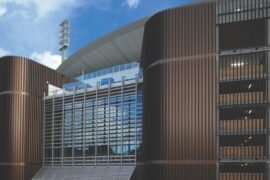The Danger Of Kitsch In The Workplace: How to experiment without making our industry look naff.
February 23rd, 2017
I’ve got a dirty little secret: I am a great admirer of Gaetano Pesce. All that melted resin, the spew like hues, the joyously informal shapes of his table, chair and lighting designs. But even I would not have wanted to work within the Pesce interior of advertising agency Chiat/Day. A mass of throbbing polyethylene gristle squished into improbable volumes scattered across an open platform, when it was unveiled in 1994 Chiat/Day L.A. was hailed as the manifestation of a new era in post-industrial office design. When it was shuttered five years later it was widely decried as a flop.
Armed with Motorola flip-phones, Chiat/Day boffins struggled to attain meaningful mobility – or even somewhere to sit. Twenty years later, we’re almost completely unleashed, but still we’ve not reached consensus on how to best articulate the workplace. Sure, the cubicle is virtually extinct, the boardroom obsolete, and yet best practice continues to elude us. Partly that’s because technology is evolving more rapidly than design. Partly because, with Boomers obliged to remain in the workforce longer, rubbing shoulderpads with GenY’s skinny pants, we’ve never had greater generational chafe. Some want beanbags, others slipperydips. Most want to just get the job done.
I find it intriguing, how swiftly the home/anywhere office fell into disrepute. Only a handful of years ago we were eulogizing hot desking in our pyjamas while making jam. The demise is mostly due to those nasty market forces: if you’re double-dipping the dining table as desk, you’re cutting retail sales by half.
So all of a sudden showrooms are filled with incredibly seductive solutions for domesticating the workplace. And some of these are very excellent indeed. Alexander Lotersztain’s Tetronimo blocks for Stylecraft have all the chutzpah of Tetris – I suspect even Pesce would appreciate their 1980s flair. (If you squint, they could look not a little like his New York Sunset sofa system of 1980.)
Then there’s David Caon’s Bloc office seating and work surface system for Living Edge. Sophisticated, the seemingly endless configuration options mean that the Bloc offering is incredibly generous. But Caon’s sensitivity to the capacity of specifiers to trip over into kitsch led him to devise a fool-proof colour/fabric matrix based on Raf Simons’ textiles for Kvadrat. Ignore it at your own peril.
The capacity to get it wrong is a real consideration. Google has filled its global offices with such fun park detritus as: ski gondolas, Montgolfier baskets, industrial evacuation chutes, trailer trash vans, basketball courts, and hippy-dippy dream pods. All the while, they’d have done a lot better if they’d invested in actual, structural solutions to their buildings rather than throwing cheap gimmicks at their workers like so many glass beads to naîve natives. The brio with which Google employees lap it up is discouraging.
In general, things to be wary of in the work arena include: tree houses, wading pools, grottoes, pagodas, pirate ships, Tarzan vines, over-zealous belief in the shipping container to point the way anywhere of interest, fake plants, treadmills (oh, the metaphor runs rife!), pouffes, repro mid-century furniture, fake Persian carpets, loft kitchens, assemblages of meaningless picture frames, thatch, table soccer… That is, of course, unless you work in the head office of Matt Blatt – in which case any of the above is fine and dandy. You can use them to furnish the special circle of hell we’ve reserved for you.
As for me, I’d still be kinda keen to kit out my home office with that Pesce wire frame and melted resin Chiat/Day desk I found on 1stdibs.com. I just need to rustle up the $US22,000.
Want the full story by Stephen Todd? Grab a copy of Indesign #68 – on sale now!
INDESIGN is on instagram
Follow @indesignlive
A searchable and comprehensive guide for specifying leading products and their suppliers
Keep up to date with the latest and greatest from our industry BFF's!

London-based design duo Raw Edges have joined forces with Established & Sons and Tongue & Groove to introduce Wall to Wall – a hand-stained, “living collection” that transforms parquet flooring into a canvas of colour, pattern, and possibility.
The new range features slabs with warm, earthy palettes that lend a sense of organic luxury to every space.

Welcomed to the Australian design scene in 2024, Kokuyo is set to redefine collaboration, bringing its unique blend of colour and function to individuals and corporations, designed to be used Any Way!

For Aidan Mawhinney, the secret ingredient to Living Edge’s success “comes down to people, product and place.” As the brand celebrates a significant 25-year milestone, it’s that commitment to authentic, sustainable design – and the people behind it all – that continues to anchor its legacy.

A custom-built big-data centre set provided the backdrop for Chanel’s spring- summer 2017 show at the recent Paris fashion week, which included models dressed as robots and bags with flashing LED displays.

Danish dynamo’s Normann Copenhagen recently unveiled their newly conceptualised flagship store in Copenhagen – and it takes this ‘pink trend’ thing to a whole new level.
The internet never sleeps! Here's the stuff you might have missed

Explore the prizes up for grabs at Saturday Indesign this year when you register and check into 10+ showrooms on the day.

With the Evershield® Anodising 50-Year Warranty, AAF offers peace of mind that architectural aluminium will remain vibrant, resilient, and beautiful for generations.